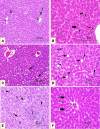Ameliorative effects of Dictyota dichotoma on hepatotoxicity induced by gibberellic acid in albino rats
- PMID: 35874501
- PMCID: PMC9247131
- DOI: 10.1007/s43188-022-00122-8
Ameliorative effects of Dictyota dichotoma on hepatotoxicity induced by gibberellic acid in albino rats
Abstract
Gibberellic acid (GA3) is a natural plant growth regulator that is crucial for plant structural and functional development. We examined the alleviating capacity of brown algae (Dictyota dichotoma) on biochemical and molecular degenerative processes caused by sub-chronic exposure to gibberellic acid resulting in hepatic cell apoptosis. Adult male albino rats were divided into five equal groups: the first group received distilled water, the second group was treated with GA3, the third group was administered D. dichotoma extract suspended in 1% carboxymethylcellulose (CMC), the fourth group was administered both GA3 and D. dichotoma simultaneously, and the fifth group received 1% CMC orally, 5 days per week for a total of 50 days. The results indicated that GA3 induced a significant increase in liver function parameters based on serum levels of alkaline phosphatase (ALP), alanine aminotransferase (ALT), aspartate aminotransferase (AST), and albumin, which indicate hepatotoxicity. A marked increase in malondialdehyde (MDA) levels and a marked decrease in reduced glutathione (GSH), glutathione-S-transferase (GST), and superoxide dismutase (SOD) were observed as a result of induction of lipid peroxidation and oxidative stress. Histopathology revealed severely degenerated hepatocytes including cytoplasmic vacuolations and many apoptotic cells with weak Bcl2 expression. Similarly, there was a significant up-regulation of gene and protein expression levels for the pro-apoptotic markers, Caspase-3 and Bax, and an increase in pro-inflammatory marker levels, tumor necrosis factor-alpha (TNF-α) and interleukin-6 (IL-6) as well as C-reactive protein (CRP). The co-administration of D. dichotoma restored the disrupted biochemical, histopathological, molecular, and inflammatory changes resulting from GA3 toxicity. Our results confirm the antioxidant, anti-inflammatory, anti-apoptotic, and hepatoprotective potential of D. dichotoma.
Keywords: Apoptosis; Brown algae; Gibberellic acid; Hepatotoxicity; Plant growth regulators.
© The Author(s) under exclusive licence to Korean Society of Toxicology 2022.
Conflict of interest statement
Conflict of interestThe authors declare that they have no competing interests.
Figures






Similar articles
-
Histological and biochemical changes induced by gibberellic acid in the livers of pregnant albino rats and their offspring: ameliorative effect of Nigella sativa.Anat Sci Int. 2019 Sep;94(4):307-323. doi: 10.1007/s12565-019-00488-0. Epub 2019 May 3. Anat Sci Int. 2019. PMID: 31054114
-
Baicalin provides protection against fluoxetine-induced hepatotoxicity by modulation of oxidative stress and inflammation.World J Hepatol. 2022 Apr 27;14(4):729-743. doi: 10.4254/wjh.v14.i4.729. World J Hepatol. 2022. PMID: 35646277 Free PMC article.
-
The Ameliorative Role of Eugenol against Silver Nanoparticles-Induced Hepatotoxicity in Male Wistar Rats.Oxid Med Cell Longev. 2022 Sep 10;2022:3820848. doi: 10.1155/2022/3820848. eCollection 2022. Oxid Med Cell Longev. 2022. PMID: 36124089 Free PMC article.
-
Ameliorative impacts of chrysin against gibberellic acid-induced liver and kidney damage through the regulation of antioxidants, oxidative stress, inflammatory cytokines, and apoptosis biomarkers.Toxicol Res (Camb). 2022 Feb 3;11(1):235-244. doi: 10.1093/toxres/tfac003. eCollection 2022 Feb. Toxicol Res (Camb). 2022. PMID: 35237428 Free PMC article.
-
Antioxidant and hepatoprotective activity of Fagonia schweinfurthii (Hadidi) Hadidi extract in carbon tetrachloride induced hepatotoxicity in HepG2 cell line and rats.J Ethnopharmacol. 2013 Dec 12;150(3):973-81. doi: 10.1016/j.jep.2013.09.048. Epub 2013 Oct 17. J Ethnopharmacol. 2013. PMID: 24140589
Cited by
-
The mitigating effect of Spirulina (Arthrospira platensis) on the hemotoxicity of gibberellic acid on juvenile tilapia (Oreochromis niloticus).Environ Sci Pollut Res Int. 2023 Feb;30(10):25701-25711. doi: 10.1007/s11356-022-23844-6. Epub 2022 Nov 8. Environ Sci Pollut Res Int. 2023. PMID: 36346524 Free PMC article.
-
Royal Jelly and Chlorella vulgaris Mitigate Gibberellic Acid-Induced Cytogenotoxicity and Hepatotoxicity in Rats via Modulation of the PPARα/AP-1 Signaling Pathway and Suppression of Oxidative Stress and Inflammation.Foods. 2023 Mar 13;12(6):1223. doi: 10.3390/foods12061223. Foods. 2023. PMID: 36981150 Free PMC article.
References
-
- Davies PJ. Plant hormones: biosynthesis, signal transduction, action! Berlin: Springer Science & Business Media; 2004.
-
- Bisht TS, Rawat L, Chakraborty B, Yadav V. A recent advances in use of plant growth regulators (pgrs) in fruit crops-a review. Int J Curr Microbiol Appl Sci. 2018;7:1307–1336. doi: 10.20546/ijcmas.2018.705.159. - DOI
-
- Shi X, Jin F, Huang Y, Du X, Li C, Wang M, Shao H, Jin M, Wang J. Simultaneous determination of five plant growth regulators in fruits by modified quick, easy, cheap, effective, rugged, and safe (QuEChERS) extraction and liquid chromatography–tandem mass spectrometry. J Agric Food Chem. 2012;60:60–65. doi: 10.1021/jf204183d. - DOI - PubMed
LinkOut - more resources
Full Text Sources
Research Materials
Miscellaneous

